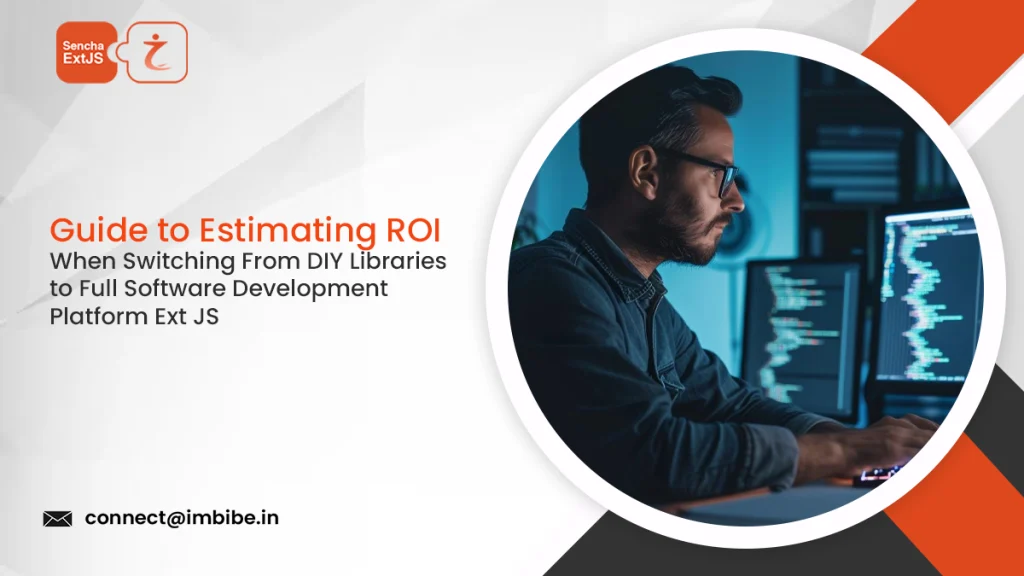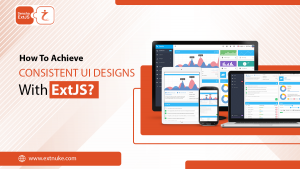Many software teams start their journey using DIY JavaScript libraries like jQuery, Bootstrap, or similar frameworks. They are easy to begin with, free to use, and seem perfect for quick prototypes. But as projects grow, these setups often struggle to keep up. You face scattered code, inconsistent designs, slow performance, and endless bug fixes.
That’s where ExtJS comes into play. Ext JS is not just another library; it is a full software development platform with built-in UI components, layouts, data handling, and theming tools. It replaces the patchwork of separate tools with one consistent, scalable solution. This guide will help you understand how to estimate ROI (Return on Investment) when moving from DIY stacks to a complete platform like Ext JS.

Why ROI Matters in Software Development Decisions
Switching tools in the middle of development is never a small decision. ROI gives you a clear picture of whether the switch will actually save time, reduce costs, and improve productivity. It’s not only about the license cost of a platform like Ext JS. It’s also about the long-term value, faster delivery, fewer bugs, happier users, and lower maintenance.
The True Cost of DIY Development
At first, DIY development feels cheaper. You download open-source tools, write your own integrations, and get things running. But hidden costs creep in:
- Integration Overhead – Every UI component, chart, or grid you add must be integrated manually. This consumes hours and slows down delivery.
- Maintenance Load – When something breaks, you must dig through custom code to fix it. Over time, fixing these issues becomes a full-time job.
- Inconsistent UI – Using multiple tools leads to a user interface that feels inconsistent across screens and devices.
- Performance Issues – DIY solutions often require extra optimization for smooth performance.
- Slow Feature Delivery – As complexity grows, adding new features takes longer.
When you sum up developer hours, delays, and missed opportunities, DIY can actually be more expensive in the long run.
The Ext JS Advantage
Ext JS offers a complete toolkit designed to handle the full application lifecycle:
- Pre-Built UI Components – Over 140 enterprise-grade components like grids, charts, forms, and pivot tables.
- Responsive Layouts – Works perfectly across devices without extra configuration.
- Data Binding – Connect to APIs and databases seamlessly.
- Built-In Theming – Consistent design out of the box with tools like Sencha Themer.
- Productivity Tools – Sencha Architect for drag-and-drop app building, automated testing, and CI/CD integration.
- Security – Built-in access controls and encrypted communication.
- Cross-Platform Support – Build once, run across browsers and devices.
With Ext JS, you skip repetitive setup tasks and focus directly on building core features.
How to Estimate ROI When Switching to Ext JS
When calculating ROI, focus on key metrics that show real business value.
1. Time to Market (TTM)
With DIY stacks, creating a functional, polished UI can take weeks. With Ext JS, pre-tested components and drag-and-drop tools can reduce that by 30–50%.
Example: A feature that takes 10 days with DIY tools might be ready in 5–6 days using Ext JS.
Formula:
ROI from TTM = (Old Time – New Time) × Daily Developer Cost
2. Developer Productivity
With Ext JS, developers spend less time debugging integrations and more time building features.
- Clean, reusable code means less rework.
- Built-in design consistency saves hours on styling.
3. Bug Reduction
Ext JS components are enterprise-tested. This reduces the bug count significantly compared to hand-coded DIY components. Fewer bugs mean:
- Faster cycles
- Lower support costs
- Happier users
4. Customer Retention
Smooth, responsive apps keep users engaged. Ext JS makes it easier to maintain high performance, which improves user satisfaction and loyalty.
5. Lower Maintenance Costs
DIY setups require ongoing patchwork updates. Ext JS delivers updates, fixes, and new features regularly, reducing long-term maintenance work.
DIY UI vs. Ext JS – A Speed Comparison
Let’s say your team needs a complex data grid with filtering, sorting, and export features.
- DIY Approach: You pick a grid library, integrate it, fix style issues, connect APIs manually, and write export logic from scratch. This could take 8–10 days.
- Ext JS Approach: Use the built-in grid component with export and filtering ready to go. The task might take 3–4 days.
Over multiple features, that difference adds up to weeks or even months saved.
Why Extnuke by Imbibe Tech Is Your Best Partner
Switching to Ext JS is a smart move, but you can make it even more powerful with professional ExtJs themes. A well-designed theme improves your app’s look and feel instantly, without extra coding.
Extnuke by Imbibe Tech specializes in ExtJS themes that are:
- Modern and responsive
- Performance-optimized
- Easy to integrate
- Customizable to match your brand
If you want your app to look polished and deliver a great user experience, it’s time to buy extjs themes from Extnuke. Our themes not only save you time but also make your application stand out in the competitive market.
Final Thoughts
Switching from DIY libraries to a full development platform like Ext JS can transform your project’s efficiency, speed, and quality. By calculating ROI based on time savings, bug reduction, and lower maintenance costs, you’ll see how quickly the investment pays off.
And when you’re ready to give your app a professional edge, Extnuke by Imbibe Tech is here to help you with top-quality ExtJs themes. Don’t waste hours fixing design inconsistencies, start strong with a theme that works perfectly from day one.
- Save time.
- Reduce costs.
- Deliver better apps.
It’s time to Buy extjs themes from Extnuke and take your Ext JS projects to the next level.

